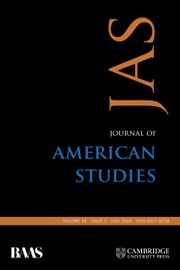Ann Mattis's excellent book offers a compelling account of the relationship between modernity and womanhood in which the domestic worker is not an archaism “superseded by [her] counterparts in the public sphere” such as typists, shopgirls and telephone operators but a figure of central importance (1). Mattis is particularly interested in how the domestic worker emerges as a vexed presence in Progressive Era discourses of reform, specifically domestic-service reform and home-economics theories espoused by Lucy Maynard Salmon, Helen Campbell, Charlotte Perkins Gilman and others. On the one hand, Gilman's feminist fiction and nonfiction derive significant rhetorical mileage from the conflation of the struggles of domestic workers with the “material oppression of housewives” (26). On the other, Gilman's work evinces a profound and eugenicist anxiety regarding her own apparently egalitarian commitments. According to Mattis in chapter 1, Gilman's New Woman “models a personal renegotiation of reproductive and productive labor in a capitalist economy and kinship order that exploits all women systematically” (36). But this New Woman “must also contend with the exploitative social relations of wage domestic work that might sustain, supplement, or contaminate her ability to emerge singularly as a figure of bourgeois exceptionalism” (36).
Placing Gertrude Stein's Three Lives (1909) in dialogue with Gilman's What Diantha Did, published in the same year, Mattis argues in chapter 2 that Stein's domestic servant tales “The Good Anna” and “The Gentle Lena” engage in a “macro critique of Progressive-era domestic reform” by revealing how the reform agenda of first-wave feminists such as Gilman was “charged with vulgar moralism, gender normativity and racial essentialism” (56). While Progressive reformers “promoted a vision of democracy that rested upon universal principles of privatized citizenship and domesticity,” Stein's servant stories in Three Lives “critique the normative and unified assumptions of both traditional family economies and the nuclear family” (79–80).
By contrast, Edith Wharton's nostalgia for a moment when employer–servant relations were almost “feudal” in character “puts her at odds with Progressive-era domestic service reforms” (86). Whereas reformers sought to “depersonalize the employer–servant relationship and standardize social relations in the home” (57), Wharton's “Female Gothic” short stories “The Lady's Maid's Bell” (1902) and “All Souls” (1934) – discussed in chapter 3 – depict a “pre-modern” model of intimacy between mistress and servant. Although this model is, on the surface of it, deeply conservative, there are moments in these texts, Mattis contends, when the labour struggles of domestic servants apparently elided by the narratives nonetheless become visible.
In chapter 4, Mattis is concerned with the role of domestic servants in the discourse of “racial uplift” during the Harlem Renaissance. The discussion of Jessie Fauset's The Sleeper Wakes (1920) and Nella Larsen's Passing (1929) reveals that African American domestic workers register ambivalently in discourses of New Negro womanhood. In the first example, black servants catalyse a renewed sense of race loyalty in the white-passing protagonist; in other words, racial solidarity trumps class differences between employer and servant. In Larsen's text, however, African American domestic workers elicit profound anxiety on the part of Irene Redfield regarding her own precarious class position within Harlem's black bourgeoisie. Passing exposes “bourgeois domesticity to be incumbent upon labor exploitation and the erasure of domestic workers’ subjectivity.” In so doing, it “critiques the discursive foundation of racial uplift” (147). The final chapter focusses on Fannie Hurst's Lummox (1923) and Imitation of Life (1933), both of which rely on “melodramatic manifestations of immigrant and black servants’ retrograde maternity” in their treatment of the psychic lives of white women (171).
Drawing on a broad range of print-culture materials – reform tracts, newspaper and magazine articles, exposés written by former domestic servants – as well as fiction, the evidentiary base of Dirty Work is rich and productive. One of the most compelling aspects of the book is its careful elucidation of the ways in which woman-centred literary genres such as the Gothic (Wharton) and melodrama (Hurst) challenge the “antisentimental pragmatism” of domestic-service reform discourse (154). While the author writes persuasively about “the particular status of German immigrant domestics in the United States” in relation to Three Lives (65), this reader was slightly disappointed that consideration was not given to the Irish domestic worker as an especially conspicuous presence in the cultural imaginary of the late nineteenth and early twentieth centuries. From the moral panic elicited by “Typhoid” Mary Mallon to Frederick Opper's “Bridget” cartoons for Puck magazine, from the protests against the Russell Brothers’ Irish servant girl vaudeville act to Sarah Orne Jewett's “Elleneen” (1901), the Irish domestic worker, arguably, evoked particular anxieties in the period Mattis explores.Footnote 1
Emphasizing the proximity of domestic workers and their employers in the home, Mattis concludes that domestic workers “have an unsettling visceral presence that often lays bare the unequal distribution of resources and opportunities under global capitalism” (196). In other words, domestic workers cannot be disavowed or ignored as easily as sweatshop workers producing US consumer goods on the other side of the world. Mattis pays careful and due attention to foundational historical and literary scholarship on domestic workers by Phyllis Palmer, Trudier Harris, David Katzman and others, as well as more recent studies by Mary Wilson and Vanessa May.Footnote 2 Dirty Work takes its rightful place among – and significantly extends – the contributions of these scholars to fostering greater understanding of the real-life and discursive function of domestic workers within US capitalist modernity.



